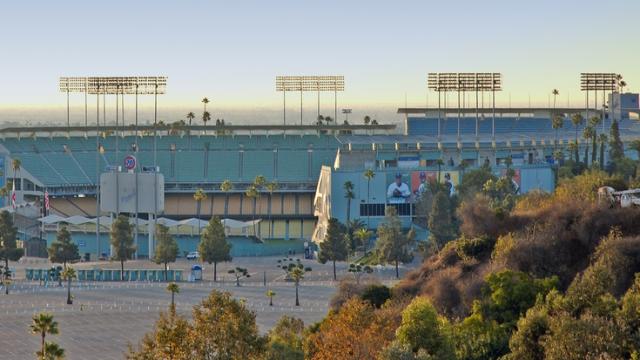Today is opening day for major league baseball, a sport that’s imbued with tradition. But this game outfitted with old-timey pinstripes and vintage Cracker Jack packaging is enjoyed in mostly contemporary spaces: 23 out of 30 teams play in stadiums that were built after 1990.
Put another way: Two-thirds of major league ballparks are below the drinking age.
Of the “old six” that will see major league action this season, all were built before 1973 (many other older ballparks are still standing but have been dedicated to different uses). There are the elder statesmen, Fenway Park and Wrigley Field, built in 1912 and 1914, respectively. Then the SoCal Moderns, Dodger Stadium (1962) and Angel Stadium (1966). The Oakland A’s play in a 1966 stadium as well, and the Kansas City Royals built theirs in 1973.

Coors Field in Denver, Colorado was built in 1995 but was designed to look like it’s been there forever (Katherine Welles / Shutterstock.com)
Then there was a long gap — 16 years — before the next stadium was built that’s still in use: The Toronto Blue Jays play in the 1989 Rogers Centre. With its fancy retractable roof and multipurpose field (Canadian football also plays there) this stadium ushered in a new contemporary era for baseball venues. Now the trend is simply to design stadiums that look old.
Although there are a handful of older parks in operation, there remains the question of whether an ageing ballpark can even serve today’s fans. The Victorian era architecture doesn’t translate so well to today’s baseball economics, so that’s why so many cities have swapped their tiny fields for megastadiums. A new ballpark allows a team to increase seating capacity and modernize facilities, especially those all-important, cash-collecting luxury boxes.

The oldest continuously used ballpark in baseball, Fenway Park in 1914 (George Grantham Bain Collection, The Library of Congress Prints & Photographs Online Catalogue)
On one hand, Fenway seems to have done it right: The stadium has undergone many upgrades through the years, the latest and most extensive being a $US285 million makeover for the 2012 season (even while preserving many of the original seats). But then we have the the ongoing saga of spiffing up Wrigley Field, where the seemingly haphazard and poorly timed renovations are starting to bleed into a fifth consecutive season. At last night’s pre-opening day opener (what is this, presidential caucus season?) the construction had still closed part of the stadium, which resulted in a urinal shortage of insanely epic proportions.
Perhaps the best example of keeping the old with the new is LA’s Dodger Stadium. The stadium was given a major refresh over the last two seasons which added much-needed amenities but managed to preserve the acclaimed modern design. (For context: Shea Stadium was built two years after Dodger Stadium, and demolished in 2009.)
But there’s another reason for Dodger Stadium’s staying power: Even though it was built way back in 1962, Dodger Stadium was and still remains the largest in baseball, seat-wise. Today it’s hosting a sold-out opening day game for about 56,000 fans — over 5000 more than any other major league stadium.
Dodger Stadium in Los Angeles (Byron W. Moore / Shutterstock.com)
